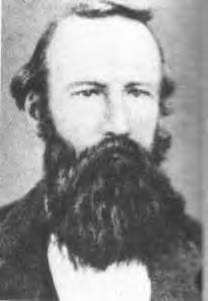Overton Young: A Son of the Old South

Overton Young, the son of Isaac N. and Mary (Austin) Young, was born in Lawrenceville, Gwinnett County, Georgia, on September 26, 1826. He was a student at Amherst College, Amherst, Massachusetts, from 1847 to 1849 but did not graduate. He studied law with the noted Georgia jurist Nathan L. Hutchins in Lawrenceville where he was admitted to the bar in 1850. Overton Young was the brother of Isaac M. Young (a twenty-year-old attorney) and William H. Young (an eighteen-year-old student at Franklin College) shown on the 1850 Gwinnett County census boarding in the home of Judge Hutchins. At the time the census was taken, twenty-three-year-old law student Overton Young was boarding in the nearby home of John F. Martin. In 1851 Overton Young began practicing law in Richmond, Fort Bend County, Texas. On May 13, 1852, he married Ann Elizabeth (Compton) Manadue, daughter of Alexander and Elizabeth Grace Compton and widow of Brazoria County, Texas, planter Warren Henry Manadue, Jr., who had died in March 1850. (Warren and Ann's four-year-old daughter Laura died in April 1850 and the census that year listed the twenty-two-year-old widow and daughters Harriet, age 3, and Lelia, age 2.) An 1853 listing of Texas lawyers indicates that Young was practicing law in Richmond and was a partner with Hiram B. Waller in the law firm of Waller & Young.
Following his marriage, Young shifted his occupation from attorney to planter, operating a sizeable sugar plantation near Sandy Point, Brazoria County, the census of 1860 indicating his acquisition of considerable wealth. By that time, Overton and Ann were the parents of four sons, Lee, Henry Cecil, Overton, Jr., and William. An additional son, Austin P., and three daughters, Anna, Fria, and Madora, were born over about the next decade.
On December 12, 1861, Young was commissioned colonel of the Twelfth Texas Infantry Regiment (erroneously referred to in some official and other records as the Eighth Texas Infantry Regiment). The Twelfth Texas Infantry was organized and mustered into Confederate service at Waco, Texas, during the spring of 1862. Its men were recruited in the cities and towns of Clarksville (Red River County), Cameron (Milam County), Hempstead (Waller County), Nacogdoches (Nacogdoches County), Fairfield (Freestone County), and Waco (McLennan County), and in the counties of Comanche, Grimes, and Milam. With other Texas infantry regiments, the Twelfth was ordered to Camp Nelson, near Austin in Prairie (but now Lonoke) County, Arkansas. There the regiment was brigaded, forming the First Brigade, with the Eighteenth (Col. William Beck Ochiltree's) and the Twenty-Second (Col. Richard B. Hubbard's) Texas Infantry regiments, the Thirteenth (Col. John Burnett's) Texas Cavalry (dismounted), and Captain Horace Haldeman's artillery battery. Young was made brigade commander but was succeeded by Lt. Col. Benjamin A. Philpott (of Freestone County). Young's First Brigade was combined with the Second (Col. Horace Randal's) Brigade and the Third (Col. George M. Flournoy's) Brigade to form the Texas Division, commanded by General Henry Eustace McCulloch. A fourth brigade of the division, commanded by Col. James Deshler was detached, soon after it was organized, for service at Arkansas Post. The Texas Division was officially known as McCulloch's Division and as the First Division, Second Corps, Army of the Trans-Mississippi Department. It became known as Walker's Texas Division, following the assumption of command by General John George Walker in November of 1862. The Texas Division, due to its ability to travel swiftly over many miles on foot earned for itself the nickname ?Walker's Greyhounds.? At Pine Bluff, Arkansas, in April 1863, Col. Overton Young was succeeded as commander of the First Brigade by Brigadier General James M. Hawes, whereupon Young again took command of the Twelfth Infantry Regiment. John C. Porter, in his memoirs (Early Days of Pittsburg, Texas, 1859-1874: Life of John C. Porter and Sketch of His Experiences in the Civil War) states that, "Here [Pine Bluff] Col. [William Beck] Ochiltree resigned. He made us a speech and left. Here also Gen. [James M.] Hawes took command of our Brigade, and we serenaded Col. Young, our former Commander."
Col. Young commanded his regiment with distinction during the Red River campaign and at the April 30, 1864, battle of Jenkins' Ferry (a crossing point on the Saline River in Louisiana) where he received a severe wound. Young's commanding officer at Jenkins' Ferry, Gen. Thomas N. Waul, commended Young for his actions during the engagement, writing "As at Mansfield and Pleasant Hill, he behaved courageously and cooly, managing his regiment with great skill and exhibiting much fitness for command." Waul further stated that the Twelfth Regiment would be deprived of one of its best officers if Young's wound prevented him from returning to his unit. Waul recommended Young for promotion. Young evidently did not return to his unit because he was president of Court Martial in Houston in 1864 and '65. In 1865, he was given a promotion to the rank of Brigadier General.
Following the war, Young returned to his Brazoria County plantation near Sandy Point where he continued his occupation as a planter. On September 8, 1877, Overton Young died in Galveston, Galveston County, Texas. His place of burial is not known, though his wife, Ann Young, is buried in Sandy Point Cemetery. Lee Young, Overton and Ann's eldest son, studied law in the early 1870?s in the Galveston law offices of George M. Flournoy. It should be noted that Overton Young usually signed himself simply using his first and last names. Various listings and sketches have shown him as having the middle initial "C" or "S," and one source listing military leaders of Texas refers to him as having "Stephen" as his middle name. An extensive search of Brazoria County, Texas, deed records gives no instances in which Overton Young signed his name using a middle name or initial.

